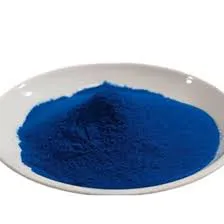Dye Production Companies and Their Impact on the Textile Industry
The Landscape of Dye Production Manufacturers
The dye production industry has become increasingly significant in today’s world, driven by the ever-expanding demand for color across various sectors including textiles, plastics, and food. Dye production manufacturers play a crucial role in this supply chain, offering a diverse array of products that cater to different applications and industries. This article delves into the landscape of dye production manufacturers, exploring their methods, challenges, and the innovations shaping their future.
Understanding Dye Production
Dyes are organic compounds that impart color to materials. They are distinguished from pigments by their ability to dissolve in a medium, resulting in vibrant hues that can be absorbed directly by substrates. The dye manufacturing process typically involves several stages including synthesis, formulation, and quality control. Manufacturers must ensure that their products meet strict regulatory standards for safety and environmental impact.
Types of Dyes
Dye production manufacturers can be classified based on the types of dyes they produce. Some of the most common categories include
1. Reactive Dyes Often used in the textile industry, these dyes form a covalent bond with the fiber, offering excellent wash and light fastness.
2. Acid Dyes Primarily used for dyeing wool, silk, and nylon, acid dyes require an acidic environment to fix the color.
3. Disperse Dyes These are used for synthetic fibers like polyester. They are insoluble in water but can be dispersed in a dye bath.
4. Natural Dyes Sourced from plants, minerals, or insects, natural dyes are gaining popularity for their eco-friendly properties.
5. Pigment Dyes Although they do not dissolve, pigment dyes are used in various industries for their stability and vividness.
dye production manufacturers

Challenges Faced by Manufacturers
Dye production manufacturers face a myriad of challenges, particularly in balancing production efficiency with environmental sustainability. Several issues include
- Regulatory Compliance Manufacturers must navigate a complex array of regulations concerning chemical safety and environmental protection. Non-compliance can lead to severe penalties and harm to their reputation.
- Sustainability As global awareness regarding the environmental impact of chemical manufacturing rises, there is pressure to adopt greener production methods. This includes minimizing waste, reducing energy usage, and sourcing raw materials responsibly.
- Market Competition The dye manufacturing sector is highly competitive, with numerous players vying for market share. Manufacturers must continuously innovate and improve their processes to maintain their foothold.
- Supply Chain Disruptions Recent global events have highlighted the fragility of supply chains. Manufacturers must adapt to fluctuations in the availability of raw materials and transportation issues.
Innovations in Dye Production
To overcome these challenges, many dye production manufacturers are embracing technological advancements. Digital dyeing technologies, for example, allow for precise color matching and reduce water consumption significantly. The use of bio-based dyes and sustainable raw materials is on the rise, reflecting a shift towards eco-friendliness in production processes.
Moreover, automation and artificial intelligence are being integrated into production workflows, enhancing efficiency and reducing human error. These innovations not only improve productivity but also enable manufacturers to respond swiftly to changing market demands.
Conclusion
Dye production manufacturers are at the heart of a vibrant and essential industry. As they navigate challenges ranging from regulatory compliance to supply chain interruptions, they also have the opportunity to innovate and lead the transition towards sustainable practices. With increasing global demand for color and the push for environmentally friendly solutions, the future of dye manufacturing looks promising, ripe with potential for growth and development. Manufacturers that embrace change while remaining committed to quality and sustainability will thrive in this evolving landscape.
-
The Timeless Art of Denim Indigo Dye
NewsJul.01,2025
-
The Rise of Sulfur Dyed Denim
NewsJul.01,2025
-
The Rich Revival of the Best Indigo Dye
NewsJul.01,2025
-
The Enduring Strength of Sulphur Black
NewsJul.01,2025
-
The Ancient Art of Chinese Indigo Dye
NewsJul.01,2025
-
Industry Power of Indigo
NewsJul.01,2025
-
Black Sulfur is Leading the Next Wave
NewsJul.01,2025

Sulphur Black
1.Name: sulphur black; Sulfur Black; Sulphur Black 1;
2.Structure formula:
3.Molecule formula: C6H4N2O5
4.CAS No.: 1326-82-5
5.HS code: 32041911
6.Product specification:Appearance:black phosphorus flakes; black liquid

Bromo Indigo; Vat Bromo-Indigo; C.I.Vat Blue 5
1.Name: Bromo indigo; Vat bromo-indigo; C.I.Vat blue 5;
2.Structure formula:
3.Molecule formula: C16H6Br4N2O2
4.CAS No.: 2475-31-2
5.HS code: 3204151000 6.Major usage and instruction: Be mainly used to dye cotton fabrics.

Indigo Blue Vat Blue
1.Name: indigo blue,vat blue 1,
2.Structure formula:
3.Molecule formula: C16H10N2O2
4.. CAS No.: 482-89-3
5.Molecule weight: 262.62
6.HS code: 3204151000
7.Major usage and instruction: Be mainly used to dye cotton fabrics.

